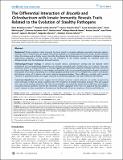| dc.contributor.author | BARQUERO-CALVO, ELIAS | |
| dc.contributor.author | Conde-Álvarez, Raquel | |
| dc.contributor.author | Chacón-Díaz, Carlos | |
| dc.contributor.author | Quesada-Lobo, LucÍa | |
| dc.contributor.author | Martirosyan, Anna | |
| dc.contributor.author | Guzman-Verri, Caterina | |
| dc.contributor.author | Iriarte, Maite | |
| dc.contributor.author | Manček Keber, Mateja | |
| dc.contributor.author | Jerala, Roman | |
| dc.contributor.author | Gorvel, Jean-Pierre | |
| dc.contributor.author | Moriyon, Ignacio | |
| dc.contributor.author | Moreno, Edgardo | |
| dc.contributor.author | Chaves-Olarte, Esteban | |
| dc.date.accessioned | 2020-10-16T21:34:47Z | |
| dc.date.available | 2020-10-16T21:34:47Z | |
| dc.date.issued | 2009-06-16 | |
| dc.identifier.uri | http://hdl.handle.net/11056/18363 | |
| dc.description.abstract | Background: During evolution, innate immunity has been tuned to recognize pathogen-associated molecular patterns. However, some a-Proteobacteria are stealthy intracellular pathogens not readily detected by this system. Brucella members follow this strategy and are highly virulent, but other Brucellaceae like Ochrobactrum are rhizosphere inhabitants and only opportunistic pathogens. To gain insight into the emergence of the stealthy strategy, we compared these two phylogenetically close but biologically divergent bacteria.
Methodology/Principal Findings: In contrast to Brucella abortus, Ochrobactrum anthropi did not replicate within professional and non-professional phagocytes and, whereas neutrophils had a limited action on B. abortus, they were essential to control O. anthropi infections. O. anthropi triggered proinflammatory responses markedly lower than Salmonella enterica but higher than B. abortus. In macrophages and dendritic cells, the corresponding lipopolysaccharides reproduced these grades of activation, and binding of O. anthropi lipopolysaccharide to the TLR4 co-receptor MD-2 and NF-kB induction laid between those of B. abortus and enteric bacteria lipopolysaccharides. These differences correlate with reported variations in lipopolysaccharide core sugars, sensitivity to bactericidal peptides and outer membrane permeability.
Conclusions/Significance: The results suggest that Brucellaceae ancestors carried molecules not readily recognized by innate immunity, so that non-drastic variations led to the emergence of stealthy intracellular parasites. They also suggest that some critical envelope properties, like selective permeability, are profoundly altered upon modification of pathogenassociated molecular patterns, and that this represents a further adaptation to the host. It is proposed that this adaptive trend is relevant in other intracellular a-Proteobacteria like Bartonella, Rickettsia, Anaplasma, Ehrlichia and Wolbachia. | es_ES |
| dc.description.abstract | Antecedentes: Durante la evolución, la inmunidad innata ha sido ajustada para reconocer patrones moleculares asociados a los patógenos. Sin embargo, algunas a-Proteobacterias son patógenos intracelulares sigilosos que no son fácilmente detectados por este sistema. Los miembros de Brucella siguen esta estrategia y son altamente virulentas, pero otras Brucellaceae como Ochrobactrum son habitantes de la rizosfera y sólo patógenos oportunistas. Para comprender la aparición de la estrategia de sigilo, comparamos estos dos bacterias filogenéticamente cercanas pero biológicamente divergentes.
Metodología/Hallazgos principales: A diferencia de Brucella abortus, Ochrobactrum anthropi no se replicaba en los fagocitos profesionales y no profesionales y, mientras que los neutrófilos tenían una acción limitada sobre B. abortus, eran esenciales para controlar las infecciones por O. anthropi. O. anthropi desencadenaba respuestas proinflamatorias marcadamente inferiores a las de Salmonella enterica pero superiores a las de B. abortus. En los macrófagos y las células dendríticas, los lipopolisacáridos correspondientes se reprodujeron estos grados de activación, y la unión del lipopolisacárido de O. anthropi al co-receptor TLR4 MD-2 y la inducción de NF-kB ...entre las de B. abortus y las de la bacteria entérica lipopolisacáridos. Estas diferencias se correlacionan con los informes variaciones en los azúcares centrales de lipopolisacáridos, sensibilidad a los péptidos bactericidas y permeabilidad de la membrana exterior.
Conclusiones/Significado: Los resultados sugieren que los antepasados de las Brucellaceae portaban moléculas no fácilmente reconocibles por inmunidad innata, de modo que las variaciones no drásticas llevaron a la aparición de sigilosos parásitos intracelulares. También sugieren que algunas propiedades críticas de la envoltura, como la permeabilidad selectiva, se alteran profundamente al modificar los patrones moleculares asociados a los patógenos, y que esto representa una adaptación adicional al huésped. Se propone que esta adaptación La tendencia es pertinente en otras a-proteobacterias intracelulares como la Bartonella, la Rickettsia, el Anaplasma, la Ehrlichia y la Wolbachia. | es_ES |
| dc.description.sponsorship | Universidad Nacional, Costa Rica | es_ES |
| dc.language.iso | eng | es_ES |
| dc.publisher | PLOS ONE | es_ES |
| dc.rights | Acceso abierto | es_ES |
| dc.rights | Attribution-NonCommercial-NoDerivatives 4.0 Internacional | * |
| dc.rights.uri | http://creativecommons.org/licenses/by-nc-nd/4.0/ | * |
| dc.source | PLoS ONE 4(6): e5893. | es_ES |
| dc.subject | BRUCELLA | es_ES |
| dc.subject | BRUCELOSIS | es_ES |
| dc.subject | BACTERIAS | es_ES |
| dc.subject | BRUCELLA ABORTUS | es_ES |
| dc.title | The differential interaction of brucella and ochrobactrum with innate immunity reveals traits related to the evolution of stealthy pathogens | es_ES |
| dc.type | http://purl.org/coar/resource_type/c_6501 | es_ES |
| dc.description.procedence | Escuela de Medicina Veterinaria | es_ES |
| dc.identifier.doi | 10.1371/journal.pone.0005893 | |


